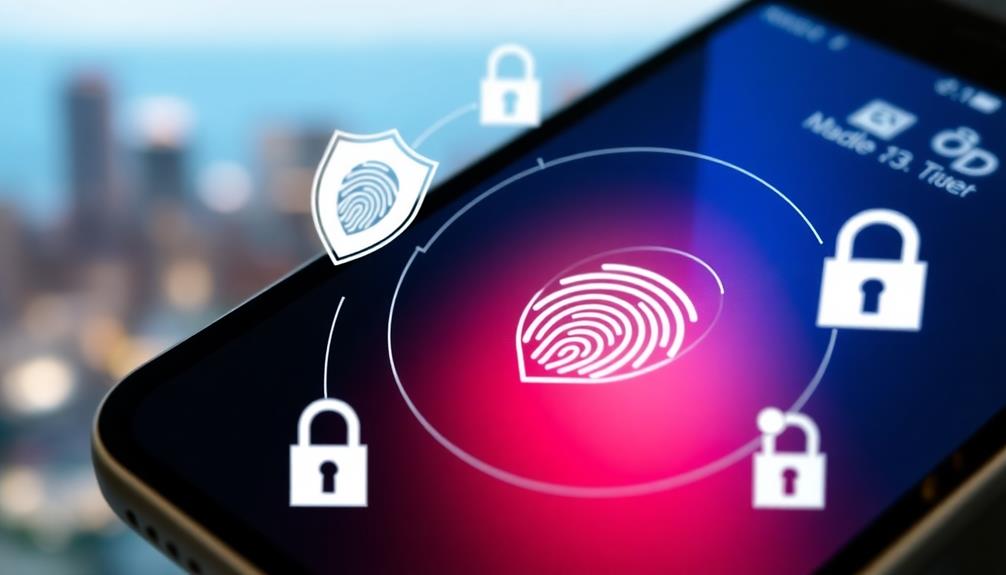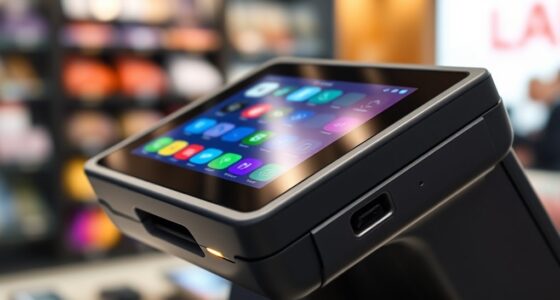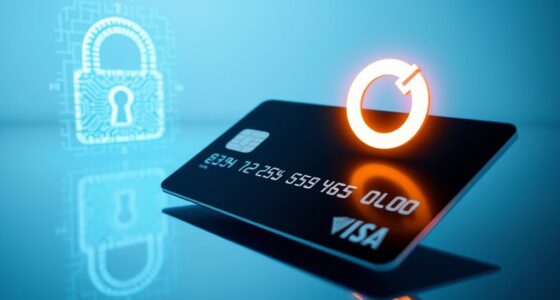Mobile payment security is essential for keeping your sensitive information safe while you make quick transactions. Apps like Apple Pay and Google Pay use advanced measures like encryption and tokenization to protect your data. However, be cautious of common risks, such as phishing attacks and unsecured public Wi-Fi. Multi-factor authentication and strong passwords can enhance your account security. Regularly update your payment apps and monitor your activity for unusual charges. By adopting best practices and staying informed, you can confidently enjoy mobile payments on the go. Discover more about the latest trends and security strategies to stay protected.
Key Takeaways
- Implement multi-factor authentication (MFA) to add extra security layers to mobile payment accounts and prevent unauthorized access.
- Regularly update payment apps to patch vulnerabilities and enhance protection against cyber threats.
- Use strong, unique passwords for each payment account to minimize the risk of breaches from compromised credentials.
- Avoid using unsecured public Wi-Fi for financial transactions; opt for a VPN to encrypt data when necessary.
- Stay vigilant against phishing attacks by recognizing fraudulent messages and employing AI-driven security solutions for real-time threat detection.
Understanding Mobile Payments
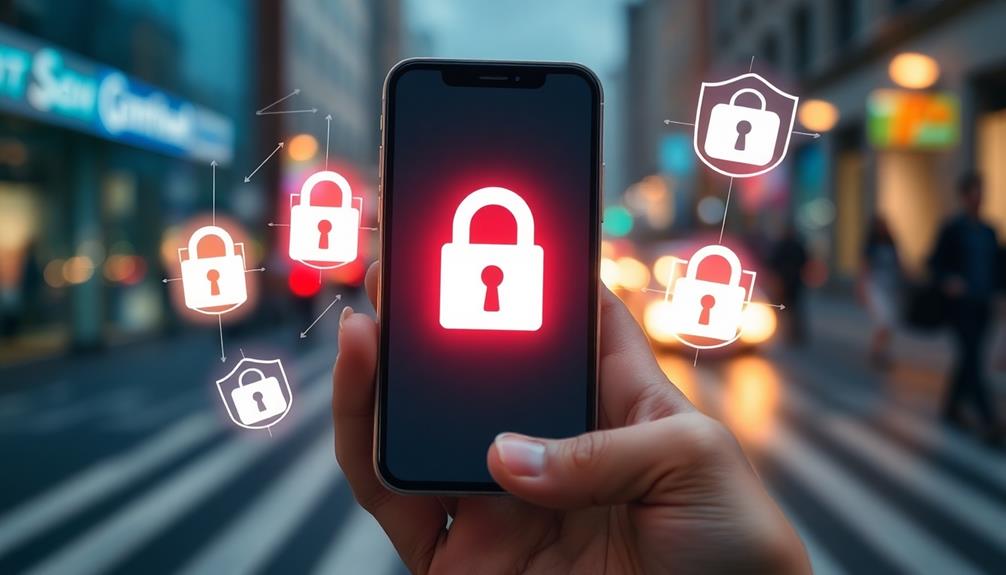
Mobile payments are revolutionizing the way you shop, allowing for quick and convenient transactions right from your smartphone, smartwatch, or tablet. With mobile payment applications like Apple Pay, Samsung Pay, and Google Pay, you can make secure payments in-store or online without fumbling for cash or credit card information.
These platforms harness technologies such as Near-Field Communication (NFC) and QR codes to facilitate seamless transactions. Additionally, understanding common financial terms such as credit scores and interest rates can enhance your ability to manage your finances effectively while using these services.
When you use mobile wallets, your sensitive information is protected through advanced security measures. Encryption and tokenization play crucial roles in safeguarding your data, ensuring that your credit card information is never directly shared with merchants. Instead, payment processors generate unique tokens for each transaction, adding an extra layer of security.
As mobile payment methods grow in popularity—projected to generate $12.06 trillion in revenue by 2027—it's essential to remain vigilant against security threats. By staying informed about the technologies and practices that protect your financial information, you can confidently embrace the convenience of mobile payments, knowing your transactions are secure.
Whether you're shopping online or at your favorite store, mobile payments are designed to keep your information safe.
Mobile Payment Functionality
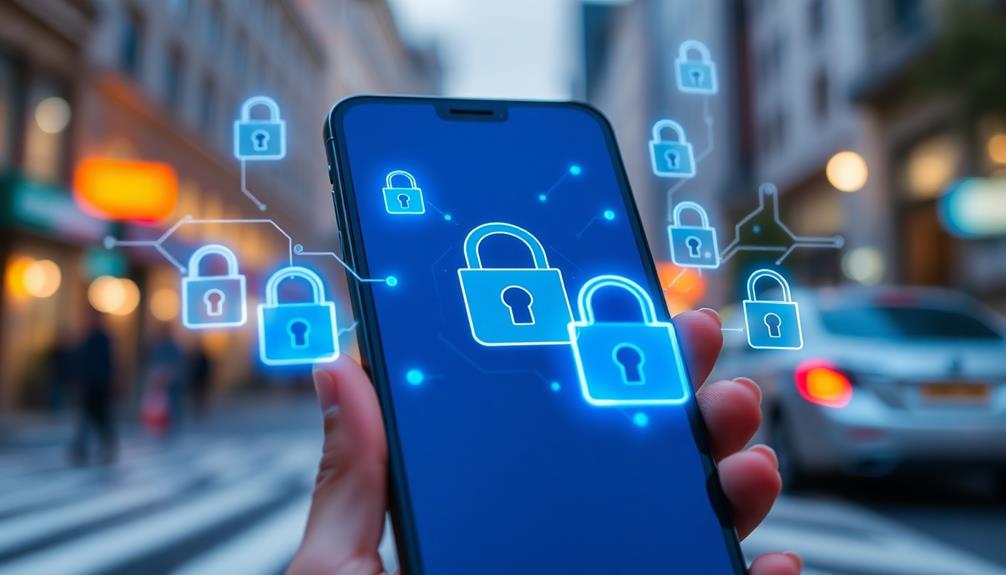
While you navigate the world of digital transactions, understanding how mobile payment functionality works can improve your shopping experience. Mobile payment systems allow you to make purchases using smartphones, smartwatches, and tablets, eliminating the need for cash or physical cards. Technologies like NFC (Near-Field Communication) and QR codes enable seamless transactions. NFC technology, for instance, facilitates contactless payments by connecting your mobile device to POS terminals.
Here's a brief overview of key components in mobile payments:
| Component | Description |
|---|---|
| Payment Apps | Platforms like Apple Pay and Google Pay store cards securely. |
| Encryption and Tokenization | Protects sensitive information during transactions. |
| Secure Network Connections | guarantees data is transmitted safely over the internet. |
| Consumer Data Protection | Safeguards your personal information from breaches. |
As the mobile payment market is projected to hit $12.06 trillion by 2027, adopting payment security best practices and understanding these functionalities can greatly improve your experience with digital payments. Embrace this shift towards convenience while prioritizing your security!
Key Security Mechanisms
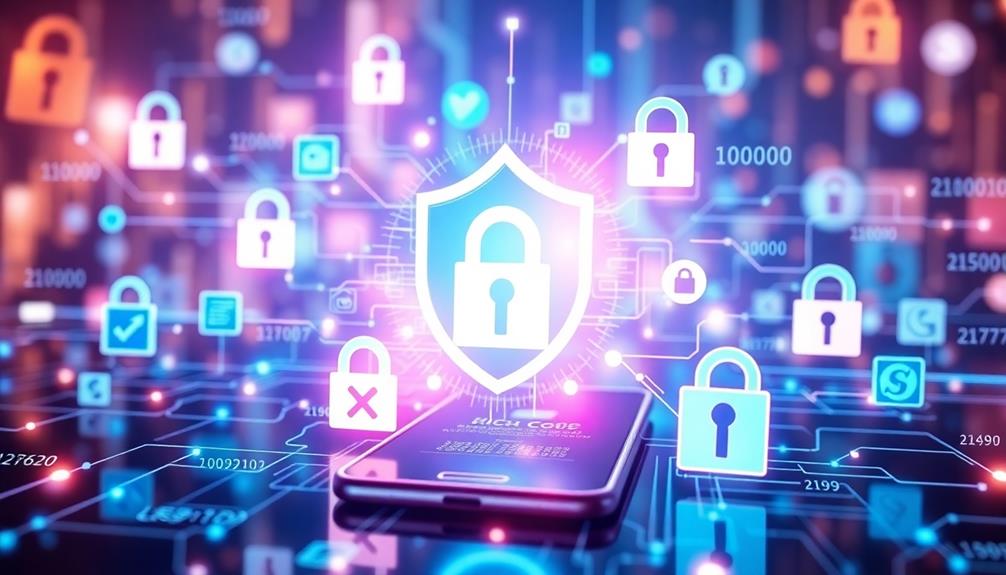
Understanding mobile payment functionality sets the stage for recognizing the importance of security in these transactions. To protect your payment information, several key security mechanisms come into play, which are essential for businesses that rely on high-risk merchant services to guarantee safe transactions.
- Tokenization: This process replaces your sensitive card details with randomly generated tokens. Even if a merchant's system gets compromised, only tokenized data is exposed, keeping your actual payment details safe.
- Multi-factor Authentication (MFA): MFA considerably enhances security by requiring various verification methods—like passwords, mobile devices, or biometric data—making unauthorized access much harder.
- Encryption: Sensitive payment information is secured through encryption during transactions. This means that if data is intercepted, it remains unreadable without the decryption key.
- Regular Software Updates: Keeping your mobile payment apps updated addresses vulnerabilities, reducing the risk of exploitation by cybercriminals.
Additionally, always use secure network connections, such as trusted Wi-Fi or VPNs, to prevent data interception during your mobile transactions.
Common Security Risks
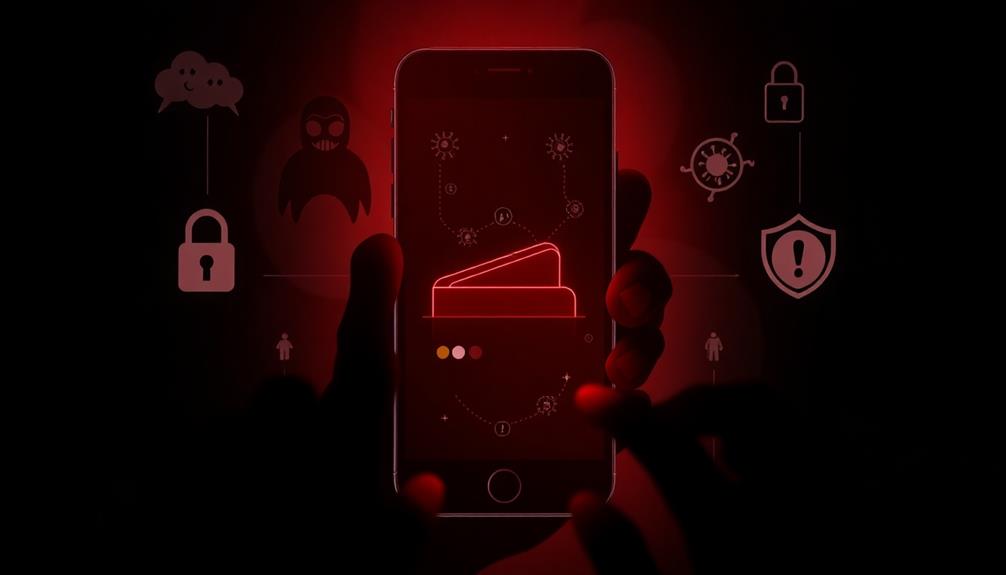
When you use mobile payment apps, you need to be aware of device vulnerabilities and phishing threats that can compromise your security.
Cybercriminals often exploit these weaknesses, targeting your sensitive information through deceptive tactics.
Monitoring your credit card statements can help you catch any fraudulent activity early.
Staying informed and vigilant is essential to protect yourself from these common risks.
Device Vulnerabilities
Mobile devices are prime targets for cybercriminals, particularly due to their inherent vulnerabilities.
You mightn't realize it, but your mobile payment security can be compromised in several ways. Employers often conduct background checks to verify candidate information, and similarly, users should verify the security of their mobile payment methods.
Here are some common risks you should be aware of:
- Lost or Stolen Devices: One in ten people experience a lost or stolen device, which can expose sensitive payment data stored on your phone.
- Weak Passwords: Using weak or reused passwords greatly increases your vulnerability; studies show that 81% of data breaches stem from this issue.
- Public Wi-Fi Risks: 90% of mobile users are unaware of the dangers associated with using unsecured public Wi-Fi for transactions, making it a prime entry point for hackers.
- User Vigilance: Human error accounts for 88% of data breaches, underscoring the importance of staying alert and cautious.
Phishing Threats
Amid the growing risks associated with device vulnerabilities, phishing threats have emerged as a vital concern for mobile payment security. A staggering 84% of organizations report experiencing mobile-based phishing attacks, which highlights the urgent need for increased awareness and vigilance.
Cybercriminals exploit human error, sending fraudulent messages that mimic legitimate sources to trick you into providing sensitive payment data. Additionally, understanding how to look up arrest warrants can further enhance your security by ensuring you aren't unknowingly involved in any legal issues that could jeopardize your financial transactions.
On mobile devices, the risk is even higher. You might be less cautious when clicking on links or downloading apps, leaving you vulnerable to data breaches. To combat these phishing threats, it's important to stay educated and recognize potential scams. Regular training for yourself and others can greatly reduce the likelihood of falling victim.
Additionally, implementing strong security measures is essential. Using strong passwords and enabling multi-factor authentication can help protect your accounts from unauthorized access, even if you inadvertently engage with a phishing attempt.
Human Error and Vulnerabilities

When you're making mobile payments, it's easy to overlook common mistakes that can lead to vulnerabilities.
With the rise of cybersecurity vulnerabilities exacerbated during outages, phishing and social engineering tactics are on the rise, and they can catch even the most vigilant among us off guard.
Common Mistakes in Transactions
In the world of mobile payments, human error and vulnerabilities can lead to significant security breaches. Understanding how to protect your transactions is crucial, especially as AI in Business increasingly enables personalized and secure payment processes.
You need to be aware of common mistakes that can jeopardize your payment security. Here are four key pitfalls to avoid:
- Weak Passwords: Using weak or reused passwords opens the door to unauthorized access. Strong, unique passwords are essential for mobile payment security.
- Public Wi-Fi: Conducting transactions over public Wi-Fi can expose your data to interception. Always use secure connections, especially when making payments.
- Lost or Stolen Devices: If your smartphone is lost or stolen, sensitive data can be easily accessed. Implement two-factor authentication to add an extra layer of security.
- Malware Downloads: Accidental downloads of malware often stem from user mistakes. Stay vigilant and practice safe browsing to protect your mobile payment security.
Phishing and Social Engineering
Mobile payment users face a growing threat from phishing and social engineering attacks, which exploit human error and vulnerabilities. With 84% of organizations experiencing mobile-based phishing scams, it's vital to recognize these security issues before they compromise your personal information.
Cyber attackers often target insecure links and emails, aiming for unauthorized access to your sensitive financial data. Understanding tactics similar to those used in gaslighting tactics can help individuals identify deceptive communications and protect their information.
Human error plays a significant role in mobile payment security breaches, with studies revealing that 88% of these breaches stem from employee mistakes. Weak or reused passwords make it even easier for cybercriminals to exploit vulnerabilities.
To safeguard your payments, it's important to adopt strong password practices and remain vigilant against suspicious communications. Regular training and education on identifying phishing attempts and social engineering tactics can dramatically reduce the risk of human error.
Best Practices for Security
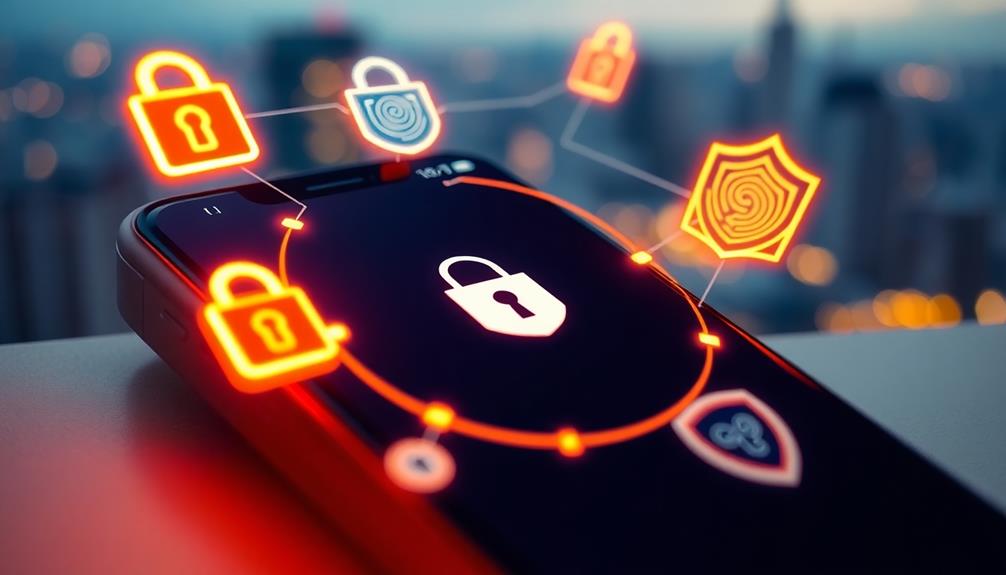
Securing your mobile payment security is essential in today's digital landscape. By following these best practices, you can protect your financial transactions on the go:
1. Use multi-factor authentication (MFA): This adds an extra layer of security by requiring multiple forms of identification, like passwords and biometric data, to access your accounts.
Additionally, just as you'd consider strategies for managing Bitcoin volatility, implementing MFA can greatly reduce the risk of unauthorized access to your financial accounts.
2. Regularly update software: Keep your mobile payment apps and device software up-to-date. Software updates and patches address vulnerabilities that cybercriminals might exploit.
3. Create strong passwords: Use unique, strong passwords for all your mobile payment accounts.
Consider using password managers to help generate and manage these secure passwords.
4. Avoid public networks: Steer clear of making transactions over unsecured public Wi-Fi.
Instead, use VPNs to secure a mobile connection for your sensitive activity.
Additionally, monitor your transaction activity regularly for any unusual or unauthorized charges.
By staying vigilant, you can mitigate potential financial losses and secure a safer mobile payment experience.
Following these best practices will help you make secure mobile transactions with confidence.
Protecting Against Phishing

Phishing scams pose a vital threat to mobile payment users, especially as these attacks have become increasingly sophisticated. With 84% of organizations reporting mobile-based phishing attempts, it's essential for you to stay alert.
AI security solutions can enhance your ability to detect these threats, as they analyze patterns and predict potential risks, making it important to integrate AI-driven protection into your cybersecurity measures. Always exercise caution when receiving unsolicited messages or links; these can lead to malicious sites designed to steal your personal information.
Recognizing common phishing tactics, like fake notifications or requests for sensitive data, can greatly reduce your risk of falling victim to these scams. Implementing strong passwords and multi-factor authentication (MFA) is important, as these security policies can help protect your accounts even if you inadvertently share information with a phishing site.
Regularly educating yourself about the latest phishing techniques is a key part of effective cybersecurity practices. Stay informed and proactive, so you can better defend against these threats.
Importance of Strong Passwords

Strong passwords are absolutely essential for securing your mobile payment transactions. With 81% of data breaches involving weak or stolen passwords, it's vital you adopt robust authentication methods.
Here are a few strategies to help you create strong passwords:
- Use Unique Passwords: Never reuse passwords across different accounts. If one gets compromised, others are at risk too.
- Mix It Up: Incorporate uppercase letters, lowercase letters, numbers, and special characters to enhance your password's security.
- Leverage Password Managers: These tools can help you generate and store complex passwords securely, reducing the temptation to opt for simpler, easily guessed options.
- Update Regularly: Change your passwords frequently, especially after any known security breach, to mitigate the risks of unauthorized access to your mobile payment accounts.
Safe Use of Public Wi-Fi
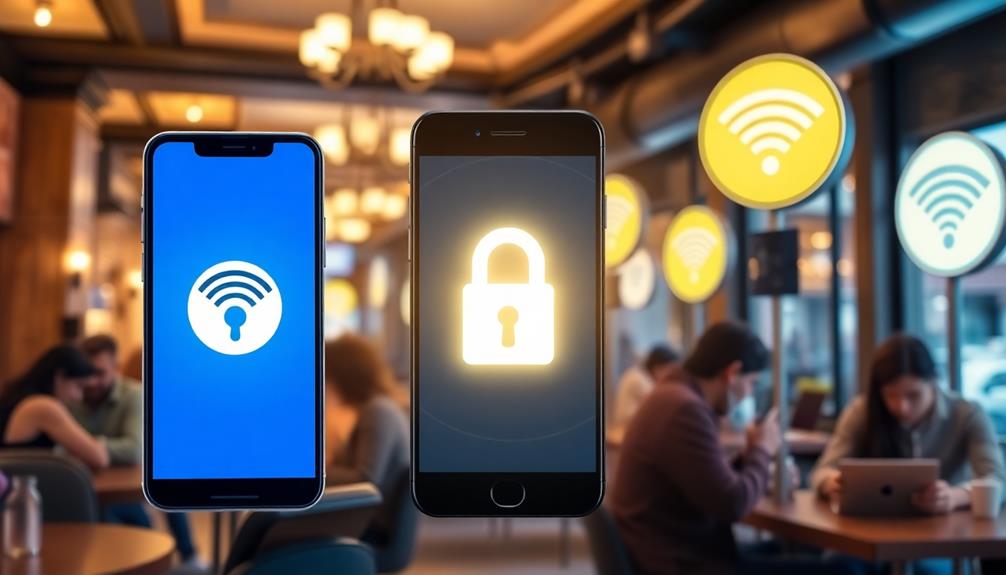
When you connect to public Wi-Fi, you're opening yourself up to risks like data interception and cybercriminal attacks.
Using a Virtual Private Network (VPN) can help encrypt your data, making it much harder for anyone to access your sensitive information during mobile payment transactions.
It's best to avoid financial activities on public networks whenever you can, opting for safer connections instead.
Risks of Public Networks
Have you ever considered the risks of using public Wi-Fi for mobile payments? While it's convenient, public Wi-Fi often lacks the robust security measures needed to protect your personal and financial information.
Using these networks can expose you to various threats, including:
- Cybercriminals: They thrive on unsecured connections, waiting to steal your data.
- Man-in-the-middle attacks: Attackers can intercept your communication with payment services, gaining unauthorized access to sensitive information.
- Data breaches: Approximately 30% of consumers have faced data breaches due to using unsecured Wi-Fi.
- Hacking threats: Public networks create fertile ground for hackers to exploit vulnerabilities.
To safeguard your mobile payments, it's wise to avoid public Wi-Fi altogether. Instead, opt for secure connections or personal hotspots whenever possible.
If you must use public Wi-Fi, consider utilizing a Virtual Private Network (VPN) to encrypt your data. This greatly enhances your security during mobile transactions, making it harder for cybercriminals to access your information.
Secure VPN Utilization
A reliable VPN is essential for anyone who frequently uses public Wi-Fi for mobile payments. When you connect to these networks, your data becomes vulnerable to cybercriminals looking to intercept transactions. By using a VPN, you encrypt your internet connection, creating a secure tunnel that protects your financial data during transmission. This means that even if someone tries to access your information, they'll only see garbled data.
Public Wi-Fi networks are prime targets for hackers, but a VPN helps mitigate these risks. It masks your IP address and encrypts your data, greatly reducing the chances of man-in-the-middle attacks, which are common in unsecured environments.
Regularly utilizing a VPN not only protects your sensitive financial information but also enhances your overall digital privacy by preventing third parties from monitoring your browsing activity.
Moreover, using a VPN is a critical step in maintaining compliance with data protection regulations. By safeguarding your data on public networks, you help guarantee that your personal and financial information remains secure from potential breaches.
Future of Mobile Payment Security

As mobile payment systems continue to evolve, the future of mobile payment security promises to be more sophisticated and user-centric.
You can expect several key advancements aimed at enhancing your transaction safety:
- Biometric Authentication: Methods like facial recognition and fingerprint scanning will become standard, boosting user verification and reducing fraud risks.
- AI-Driven Fraud Detection: Advanced algorithms will enable real-time fraud detection and transaction monitoring, ensuring your payments stay secure.
- Blockchain Technology: This will provide increased transparency and security through decentralized ledger systems, greatly lowering the risk of data breaches.
- Multi-Factor Authentication (MFA): As contactless payments gain popularity, MFA will be essential in safeguarding transactions and preventing unauthorized access.
Additionally, regulatory compliance will adapt to emerging security challenges, ensuring organizations implement robust data protection measures.
You'll find that these innovations not only enhance security but also streamline your payment experience.
Embracing these technologies will empower you to transact confidently in an increasingly digital world, knowing that your financial information is protected.
Frequently Asked Questions
How Do You Keep Your Money Safe When Doing Mobile Transactions?
To keep your money safe during mobile transactions, use strong passwords, enable two-factor authentication, and connect through secure networks. Regularly update your apps and stay vigilant against phishing scams to protect your financial information.
Are Mobile Payments More Secure?
Yes, mobile payments can be more secure. They use encryption and tokenization, reducing risks. However, you still need to stay vigilant against phishing scams and make certain your device is regularly updated for peak protection.
Does Tapping Your Phone for Payment Pose a Security Risk?
Tapping your phone for payment can pose a security risk if your device is lost or stolen. However, with proper measures like tokenization and biometric authentication, you can markedly reduce potential vulnerabilities and enhance security.
What Are Some of the Security Practices to Employ When Using a Mobile Wallet?
When using a mobile wallet, employ two-factor authentication, use strong passwords, regularly update your apps, connect only to secure networks, and stay vigilant against phishing attempts to enhance your transaction security.
Conclusion
As you navigate the bustling world of mobile payments, remember that security is your trusty shield. By understanding key risks and implementing strong protections, you can confidently transact on the go. Always stay vigilant against phishing and avoid public Wi-Fi pitfalls. With each secure transaction, you're not just protecting your wallet; you're safeguarding your peace of mind. Embrace the future of mobile payment security, and let your financial freedom flourish without fear.

